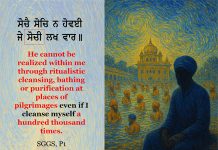
By Harbans Singh Kandola | Opinion |
(This is the sixth of a 7-part series on Misinterpretation of Gurbani. Click for Part 1, Part 2, Part 3, Part 4, Part 5, Part 6 and Part 7. Click here for all articles by the same author)
Note. Reading this article requires concentration. Kabirji in this SHABAD talks about STATAE OF SEHAJ, BLISS, ECSTASY, ANAND. The literal interpretation takes away the essence.
The purpose of listening to and reading Gurbani is so that we can change our thoughts, habits and behavior. We can change our negative thought process to a positive thought process.
In this context Professor Sahib Singh very eloquently has explained the process of interpretation of Gurbani. He wrote that when translating Gurbani in its real essence or perspective, we must be aware of two aspects:
- The central message of the hymn, contained in the verse marked RAHAO (PAUSE), must be properly understood in its real perspective.
- The message in the interpretation should be relevant to the reader’s daily life: how this guides the reader to realize the meaning and purpose of life; how such teaching brings peace and happiness in life.
I have taken hymn on page 333 from Sri Guru Granth Sahib (SGGS) to illustrate this spiritual principle of Gurbani.
Sehaj Kee Akath Katha Hai Niralee.
Tull Nahee Charai Jaai Na Mukatee, Halkee Lagai Na Bharee. (Rahao).
ਸਹਜ ਕੀ ਅਕਥ ਕਥਾ ਹੈ ਨਿਰਾਰੀ ॥
ਤੁਲਿ ਨਹੀ ਚਢੈ ਜਾਇ ਨ ਮੁਕਾਤੀ ਹਲੁਕੀ ਲਗੈ ਨ ਭਾਰੀ ॥੧॥ ਰਹਾਉ ॥
This verse has been literally interpreted as: the description of the state of intuitive poise is indescribable and sublime. It is not measured, and it is not exhausted. It is neither very light nor very heavy.
Prof Sahib Singh wrote that Sikh scholars mistakenly translated this verse as if it was about the abode, dwelling or indescribable state of TRANSCENDENT (NIRGUN) GOD, PARMESAR, that cannot be explained, destroyed or measured. That is neither very light nor very heavy.
One, as we will learn, this erroneous interpretation does not reflect the true perspective of the central idea of the hymn. Two, the message has no relevance for our daily life. It contains no spiritual guidance for our way of life.
I may point out here that when translation of Gurbani is done without following the basic principles of spiritual philosophy of SGGS, Sikh scholars end up with misleading and distorted views of Gurbani.
Let me now try to explain the true perspective of this verse.
SEHAJ ਸਹਜ – state of enlightened consciousness, bliss.
AKATH KATHA ਅਕਥ ਕਥਾ – which cannot be explained through normal human experience.
NIRALEE ਨਿਰਾਰੀ – unique, exceptional.
TULL NAHEE CHARAI ਤੁਲਿ ਨਹੀ ਚਢੈ – which cannot be described in terms of measurement and weight. Which cannot be compared with worldly comforts.
JAAI NA MUKATEE ਜਾਇ ਨ ਮੁਕਾਤੀ – infinite, unlimited.
Prof Sahib Singh wrote that this hymn is all about the state of enlightened consciousness (SEHAJ AWASTHA). In the spiritual philosophy of SGGS, sehaj awastha is described as a state in which there is complete ecstasy, bliss, inner peace and joy. There is complete freedom from mind dominance and ego, material world, wealth, power and fame. Nanak says
Rasna Gunn Gopal Nidh Gaenn. Shant Sehaj Rahas Mann Opjio Saglai Dookh Plaenn (SGGS page 713)
ਰਸਨਾ ਗੁਣ ਗੋਪਾਲ ਨਿਧਿ ਗਾਇਣ ॥ ਸਾਂਤਿ ਸਹਜੁ ਰਹਸੁ ਮਨਿ ਉਪਜਿਓ ਸਗਲੇ ਦੂਖ ਪਲਾਇਣ ॥੧॥ ਰਹਾਉ ॥
meaning by meditating on divine wisdom and godly virtues we realize a state of enlightenment, inner peace, happiness and bliss in life.
SAINT KABIR says the state of enlightened consciousness (sehaj awastha) is very unique and exceptional. This enlightened state cannot be explained through normal human experience. This cannot be described or explained in terms of some measurement, weight or any kind of worldly comforts. The other three verses of this hymn contain a detailed explanation or description of the state of enlightened consciousness (sehaj awastha).
VERSE ONE
Teh Pawas Sindhu Dhoop Nahee Chhaheeaa, Teh Utpat Parlau Nahee.
Jiwan Mirat Na Dukh Sukh Biapai, Sunn Samad Do-Oo Teh Nahee.
ਤਹ ਪਾਵਸ ਸਿੰਧੁ ਧੂਪ ਨਹੀ ਛਹੀਆ ਤਹ ਉਤਪਤਿ ਪਰਲਉ ਨਾਹੀ ॥
ਜੀਵਨ ਮਿਰਤੁ ਨ ਦੁਖੁ ਸੁਖੁ ਬਿਆਪੈ ਸੁੰਨ ਸਮਾਧਿ ਦੋਊ ਤਹ ਨਾਹੀ ॥੧॥
This verse literally has been interpreted as: there is no rainy season, ocean, sunshine or shade, no creation or destruction. No life or death, no pain or pleasure is felt there (in the abode or state of transcendent God). There is only primal trance of samadee and no duality.
We discussed above that this hymn is all about an ENLIGHTENED STATE OF CONSIOUSNESS. To say that in this state there is no rainy season, ocean, sunshine, shade, life or death, pain or pleasure, is completely irrelevant to the spiritual message of Saint Kabir. Each verse of Gurbani is guidance for spiritual awakening.
I will try to discuss this verse in its real perspective. It is important to understand the essence of the words.
TEH ਤਹ — STATE OF ENLIGHTENED CONSIOUSNESS.
PAWAS ਪਾਵਸ means RAIN. In the Hindu Vedic belief system Indar Avtar is the king of rain. Pawas refers to the kingdom of Indar. Similarly:
SINDHU ਸਿੰਧੁ – Kingdom of VISHNU AVTAR.
DHOOP ਧੂਪ – Kingdom of SUN AVTAR.
CHHAHEEAA ਛਹੀਆ — Kingdom of MOON AVTAR.
UTPAT ਪਰਲਉ — Kingdom of BRAHMA AVTAR.
SUNN ਸੁੰਨ — Complete detachment from form, material objects.
SAMAD ਸਮਾਧਿ — Awakened consciousness.
DO-OO ਦੋਊ – Duality.
Without going into details, research shows that in Gurbani references have been made to the kingdoms of INDAR, VISHNU, BRAHMA, SUN AND MOON. Hindus long to reach these so-called places of mini heavens after death. They believe these to be a means to peace, security and salvation.
Saint Kabir in this verse says that longing for these kingdoms to realize peace, security and salvation is worthless ritual. Kabir says in the enlightened state of consciousness we do not need to look up to these kingdoms for realizing meaning and purpose of life, or for inner peace and happiness. Kabir says in this state we rise above fear of death and learn to accept and surrender to HUKAM, WILL OF GOD. Kabir says we learn to be calm and stable when faced with challenges of daily life, good times or bad times. In this state we are able to rid our thoughts of negativity and rise above attachment to material wealth, power and fame. In this state, duality is eliminated, which means that identification with self as separate from God is replaced with a connection to the divine wisdom within. We are then guided by divine wisdom rather than the conditioned mind.
VERSE TWO
Ardh Urdh Do-Oo Teh Nahee, Raat Dinas Teh Nahee.
Jall Nahee Pawan Pawak Phun Nahee, Satgur Taha Samahee.
ਅਰਧ ਉਰਧ ਦੋਊ ਤਹ ਨਾਹੀ ਰਾਤਿ ਦਿਨਸੁ ਤਹ ਨਾਹੀ ॥
ਜਲੁ ਨਹੀ ਪਵਨੁ ਪਾਵਕੁ ਫੁਨਿ ਨਾਹੀ ਸਤਿਗੁਰ ਤਹਾ ਸਮਾਹੀ ॥੨॥
Literally translated as: neither lower, nor upper worlds are there, neither day nor night are there. There is no water, wind or fire. There, the true Guru is contained.
Again, this erroneous translation does not reflect the true perspective of the central verse of the hymn. It contains little or no spiritual message for our daily way of life. It becomes clear here that in order to understand the real message of the hymn we need to go deeper into the true meaning and essence of the words.
ARDH URDH ਅਰਧ ਉਰਧ does not mean lower or upper worlds. Rather it means discriminatory thoughts in our mind. It means labelling others high, low, good or bad.
RAAT DINAS TEH NAHEE ਰਾਤਿ ਦਿਨਸੁ ਤਹ ਨਾਹੀ refers to being unaware of the meaning and purpose of life; being identified with ego, and craving for more and more.
JALL ਜਲੁ means engulfed in vices and negative thoughts.
PAWAN ਪਵਨੁ means ego, ignorance and mind dominance.
PAWAK ਪਾਵਕੁ means craving for material wealth.
Kabir says in the state of awakened and enlightened consciousness we stop labelling high, low, good or bad. Our discriminatory thoughts vanish. We treat everyone as equal. We realize meaning and purpose of life, who we are, our true nature. We rise above the craving for more and more material objects. We do not get engulfed in human vices and negative thought process. We remain in a state of bliss, joy and ecstasy. In this state we realize the divine within.
VERSE THREE.
Agam Agochar Rahai Nirantar, Gur Kirpa Te Laheeaa.
Kaho Kabir Bal Jao Gur Apane, Satsangat Mill Raheeaa.
ਅਗਮ ਅਗੋਚਰੁ ਰਹੈ ਨਿਰੰਤਰਿ ਗੁਰ ਕਿਰਪਾ ਤੇ ਲਹੀਐ ॥
ਕਹੁ ਕਬੀਰ ਬਲਿ ਜਾਉ ਗੁਰ ਅਪੁਨੇ ਸਤਸੰਗਤਿ ਮਿਲਿ ਰਹੀਐ ॥੩॥੪॥੪੮॥
Literally translated as: the inaccessible and unfathomable lord dwells there within Himself. By Gurus grace He is found.
As discussed before, this hymn is about SEHAJ AWASTHA, enlightened consciousness. Kabir says the unknowable supreme reality, that is beyond the reach of every day thought and experience, is with me in my every thought, every action. Gur Mere Sang Sda Hai Nalai ਗੁਰੁ ਮੇਰੈ ਸੰਗਿ ਸਦਾ ਹੈ ਨਾਲੇ meaning I am guided by divine wisdom every step of my life. I pray that I may never be separated from my beloved SATGURU, the universal life energy, essence of my life. This realization of divine wisdom within me is by Guru’s grace.
SUMMARY
Proper interpretation of Gurbani is critical. The Sikh Psyche, Sikh thought can only be changed and transformed when the true message, the real perspective of Gurbani is presented to Sikh Sangat. The only reason that this has not happened and is not happening is that the message of Gurbani has been misunderstood, misinterpreted, and distorted over the past 250 years. This is why it is of paramount importance that a standard document listing basic principles of Sikhi be prepared by a team of Sikh scholars. This should become a standard guide for Sikh scholars and Parcharaks.
It is a mistake to interpret Gurbani based on historical events in Sikh history, because Sikh history has been largely written by those who subscribed to Vedantic belief systems. Rather, Sikh history should be explained in the context of the spiritual philosophy of SGGS. Also, in Gurbani metaphor, parable and terms of ancient philosophy have been extensively used. Interpreting these words literally is a mistake. We need to find the essence of the words.

Harbans Singh Kandola. Born in Ludhiana, Punjab, he read Ph.D. in Agriculture from Punjab Agriculture University in 1972. He moved to Canada in 1973 and retired as senior bank manager in 2005. He reads Gurbani passionately to understand its spiritual message and how it matters in his daily life. He read Prof Sahib Singh’s ‘Sri Guru Granth Sahib Darpan’ (SGGS translation) in five years, with complete notes. In the past two decades, Harbans has engaged in Gurbani discussion in radio and television programmes, as well as newspapers and the Sikh Bulletin. He believes that we now have literature with the true and real message of Gurbani which has to be presented to Sikhs and non-Sikhs. This article is from his unpublished book ‘Renaissance of Sikhi’.
RELATED STORY:
Misinterpretation of Gurbani – Introduction (Asia Samachar, 2 Sept 2022)
Lost in Translation (Asia Samachar, 8 May 2019)
ASIA SAMACHAR is an online newspaper for Sikhs / Punjabis in Southeast Asia and beyond.Facebook | WhatsApp +6017-335-1399 | Email: editor@asiasamachar.com | Twitter | Instagram | Obituary announcements, click here































